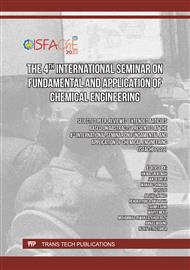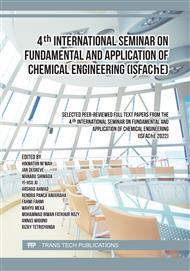[1]
A. O. Brahim and S. Abderafi, "Optimization of Energy Consumption and CO2 Reduction of Distillation Column in Oil Process," 2018.
Google Scholar
[2]
M. Hoeven, "Energy and Climate Change," Inetrnational energy Agency, 2015.
Google Scholar
[3]
M. A. Gadalla, Z. Olujic, P. J. Jansens, M. Jobson, and R. Smith, "Reducing CO2 emissions and energy consumption of heat-integrated distillation systems," Environ Sci Technol, vol. 39, no. 17, p.6860–6870, 2005.
DOI: 10.1021/es049795q
Google Scholar
[4]
Z. Hu, C. Li, and D. Zhang, "Interactions of dynamic supercritical CO2 fluid with different rank moisture-equilibrated coals: Implications for CO2 sequestration in coal seams," Chinese Journal of Chemical Engineering, vol. 35, p.288–301, 2021.
DOI: 10.1016/j.cjche.2020.10.020
Google Scholar
[5]
R. Lindsey and L. Dahlman, "Climate change: Global temperature," Climate. gov, vol. 16, 2020.
Google Scholar
[6]
J. K. Nayak and U. K. Ghosh, "Microalgal remediation of anaerobic pretreated pharmaceutical wastewater for sustainable biodiesel production and electricity generation," Journal of Water Process Engineering, vol. 35, p.101192, 2020.
DOI: 10.1016/j.jwpe.2020.101192
Google Scholar
[7]
M. Zhen, B. Song, X. Liu, R. Chandankere, and J. Tang, "Biochar-mediated regulation of greenhouse gas emission and toxicity reduction in bioremediation of organophosphorus pesticide-contaminated soils," Chin J Chem Eng, vol. 26, no. 12, p.2592–2600, 2018.
DOI: 10.1016/j.cjche.2018.01.028
Google Scholar
[8]
S. Mokhatab and W. A. Poe, Handbook of natural gas transmission and processing. Gulf professional publishing, 2012.
Google Scholar
[9]
Samir A, Ali N, and Ali S, "Gas Condensate Stabilization Methods: Optimum Operating Conditions," International Journal of Recent Technology and Engineering (IJRTE), 2019.
DOI: 10.35940/ijrte.c4430.098319
Google Scholar
[10]
H. Uwitonze, K. S. Hwang, and I. Lee, "Modelling and improving natural gas condensate process with stripping and heat integration," Chemical Engineering and Processing: Process Intensification, vol. 118, p.71–77, 2017.
DOI: 10.1016/j.cep.2017.04.022
Google Scholar
[11]
A. K. Jana, "Heat integrated distillation operation," Applied Energy, vol. 87, no. 5, p.1477–1494, 2010.
DOI: 10.1016/j.apenergy.2009.10.014
Google Scholar
[12]
K. J. Chua, S. K. Chou, and W. M. Yang, "Advances in heat pump systems: A review," Appl Energy, vol. 87, no. 12, p.3611–3624, 2010.
DOI: 10.1016/j.apenergy.2010.06.014
Google Scholar
[13]
A. A. Kiss, S. J. F. Landaeta, and C. A. I. Ferreira, "Towards energy efficient distillation technologies–Making the right choice," Energy, vol. 47, no. 1, p.531–542, 2012.
DOI: 10.1016/j.energy.2012.09.038
Google Scholar
[14]
N. Moghadam and M. Samadi, "Gas condensate stabilization unit: different design approaches," International Journal of Chemical Engineering and Applications, vol. 3, no. 6, p.461, 2012.
DOI: 10.7763/ijcea.2012.v3.244
Google Scholar
[15]
O. S. L. Bruinsma et al., "The structured heat integrated distillation column," Chemical Engineering Research and Design, vol. 90, no. 4, p.458–470, 2012.
DOI: 10.1016/j.cherd.2011.08.023
Google Scholar
[16]
M. C. Tohăneanu, V. Pleşu, P. Iancu, G. Bumbac, A. E. B. Ruiz, and J. B. Ruiz, "Simulation and process integration of clean acetone plant," CHEMICAL ENGINEERING, vol. 39, 2014.
DOI: 10.1016/b978-0-444-63455-9.50083-0
Google Scholar
[17]
R. Taboada and C. I. Ferreira, "Compression resorption cycles in distillation columns," 2008.
Google Scholar
[18]
J. C. Campbell, K. R. Wigal, V. van Brunt, and R. S. Kline, "Comparison of energy usage for the vacuum separation of acetic acid/acetic anhydride using an internally heat integrated distillation column (HIDiC)," Separation Science and Technology, vol. 43, no. 9–10, p.2269–2297, 2008.
DOI: 10.1080/01496390802151617
Google Scholar
[19]
Ž. Olujić, L. Sun, A. de Rijke, and P. J. Jansens, "Conceptual design of an internally heat integrated propylene-propane splitter," Energy, vol. 31, no. 15, p.3083–3096, 2006.
DOI: 10.1016/j.energy.2006.03.030
Google Scholar
[20]
Z. Fonyo and N. Benkö, "Comparison of various heat pump assisted distillation configurations," Chemical Engineering Research and Design, vol. 76, no. 3, p.348–360, 1998.
DOI: 10.1205/026387698524776
Google Scholar
[21]
M. A. Gadalla, "Internal heat integrated distillation columns (iHIDiCs)—new systematic design methodology," Chemical Engineering Research and Design, vol. 87, no. 12, p.1658–1666, 2009.
DOI: 10.1016/j.cherd.2009.06.005
Google Scholar
[22]
M. Gadalla, L. Jiménez, Z. Olujic, and P. J. Jansens, "A thermo-hydraulic approach to conceptual design of an internally heat-integrated distillation column (i-HIDiC)," Computers & Chemical Engineering, vol. 31, no. 10, p.1346–1354, 2007.
DOI: 10.1016/j.compchemeng.2006.11.006
Google Scholar
[23]
R. Smith and O. Delaby, "Targeting flue gas emissions," Chemical Engineering Research and Design;(United Kingdom), vol. 69, no. A6, 1991.
Google Scholar
[24]
M. A. Stadtherr, "Analysis, Synthesis, and Design of Chemical Processes by Richard Turton, Richard C. Bailie, Wallace B. Whiting, and Joseph A. Shaeiwitz," Chemical Engineering Education, vol. 32, no. 4, p.268–277, 1998.
DOI: 10.1002/cite.330711124
Google Scholar
[25]
R. Sinnott and G. Towler, Chemical engineering design: SI Edition. Butterworth-Heinemann, 2019.
Google Scholar



